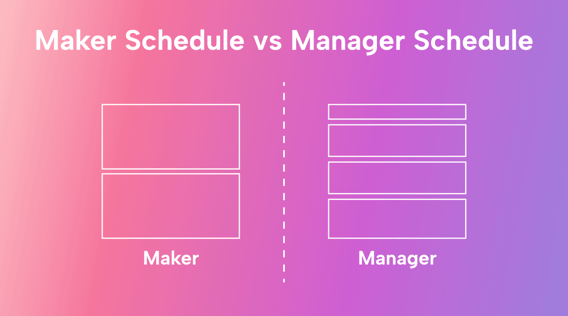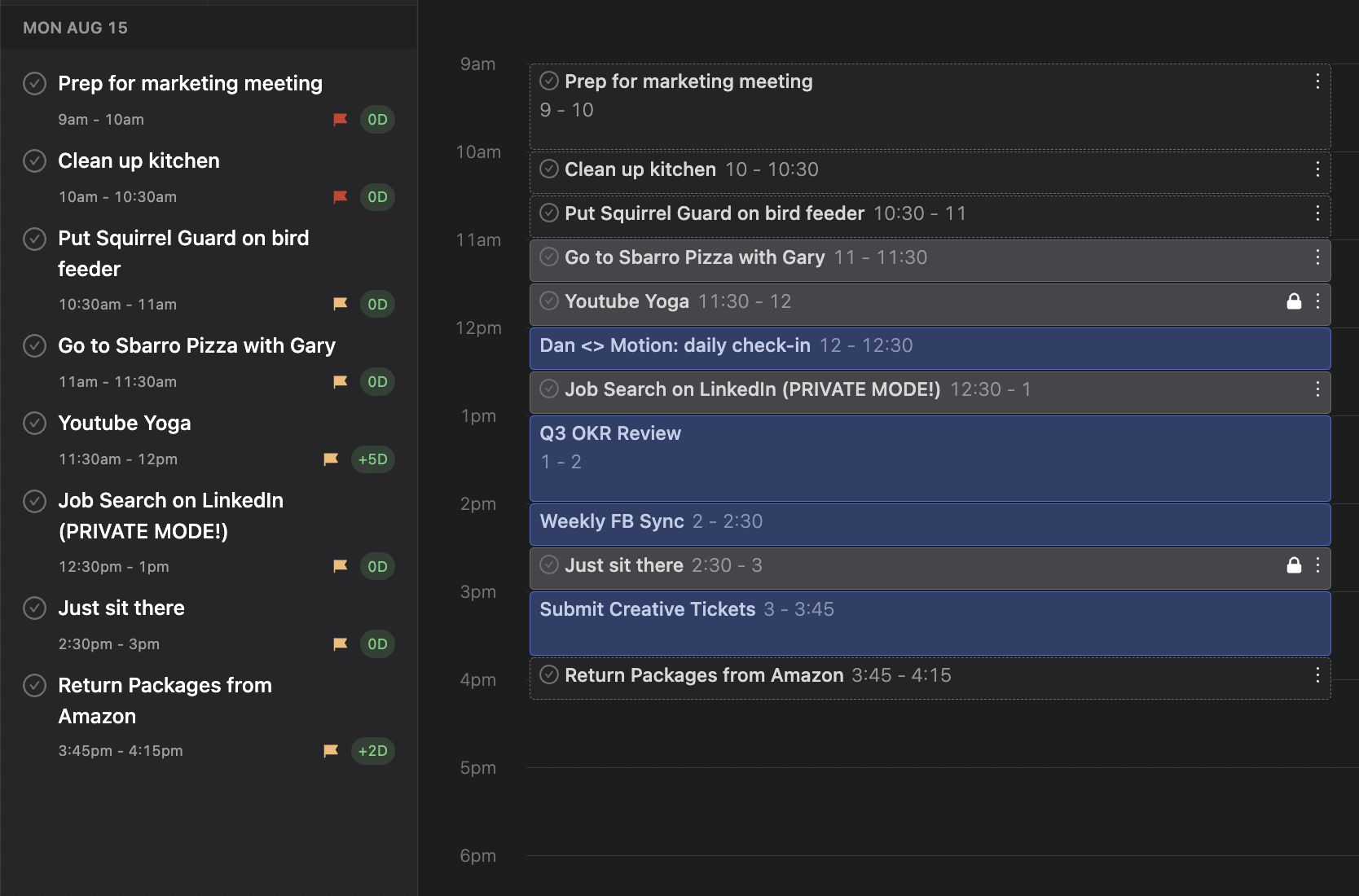Are you familiar with the challenge of managing your time effectively?
It’s a struggle many of us face, especially when juggling creative work and managerial duties. That’s where the concept of maker schedule vs. manager schedule comes into play.
It offers a framework to help us find the proper schedule (or mix of them) to suit our roles.
Paul Graham's found this framework back during the evolution of work dynamics. Over time, people realized that different tasks required different approaches. The maker’s schedule required uninterrupted time for focused work. And the manager’s schedule evolved to meet the demands of overseeing teams.
In this guide, we'll go into the intricacies of the maker and manager schedule. We’ll also:
- Explore the nature of maker schedule vs. manager schedule
- Uncover potential challenges & solutions
- Talk about hybrid options
- Go over practical strategies for both
- Reveal how Motion can help both types of schedules
Let's jump right in.
What is a maker’s schedule?
A maker's schedule is a time management framework designed for creative individuals who need time blocks for focused work. It suits people like writers, coders, engineers, architects, and others who create things.
Makers require blocked times so that they can fully immerse themselves in their projects and let their creativity flow. That’s why distractions are the enemy of a productive maker's schedule.
 |
Recent studies have found that multitasking can kill up to 40% of your daily productivity. That's a massive drop if you are tasked with a lot of creative work and need to produce. Adopting a maker's schedule can help creative professionals structure their time to work on one single task at a time (without interruptions).
Imagine a writer who sets aside three hours each morning to work on their novel (disconnect from social media, phone, and other external distractions). That writer will make serious progress compared to peers who might be checking their smartphones, even if just for a few minutes an hour. Ditto for coders and engineers who can find value in allocating chunks of time to tackle their work.
What is a manager’s schedule?
A manager's schedule is a framework that helps those with various duties while handling teams, reports, and systems. Managers need to be flexible and adaptable, yet maintain structure in their workflow.
Unlike the maker, the success of a manager's work doesn't lie solely in what they produce themselves. Instead, success equals what the team accomplishes (and the enemy is an unorganized chaos of tasks and resources).
Consider a construction project manager. A good manager’s schedule involves setting aside specific time blocks for team meetings, updates, and planning.
 |
Managers can use strategies like task labeling to balance managerial and individual work. Here you label tasks based on urgency to identify which tasks to focus on first.
When working with evolving requirements, managers could use daily stand-up meetings. Stand-up meetings are an Agile project management ceremony used to facilitate short, daily meetings that help stay the course on a project and empower team members.
And, just like makers, managers can fence off dedicated time for focused work to focus on tasks like strategic thinking, allocating, and project planning.
Maker schedule vs. manager schedule paradox
Both maker and manager schedules are distinct time management approaches, each tailored to suit specific roles. They have also sparked a paradox known as the maker-manager paradox.
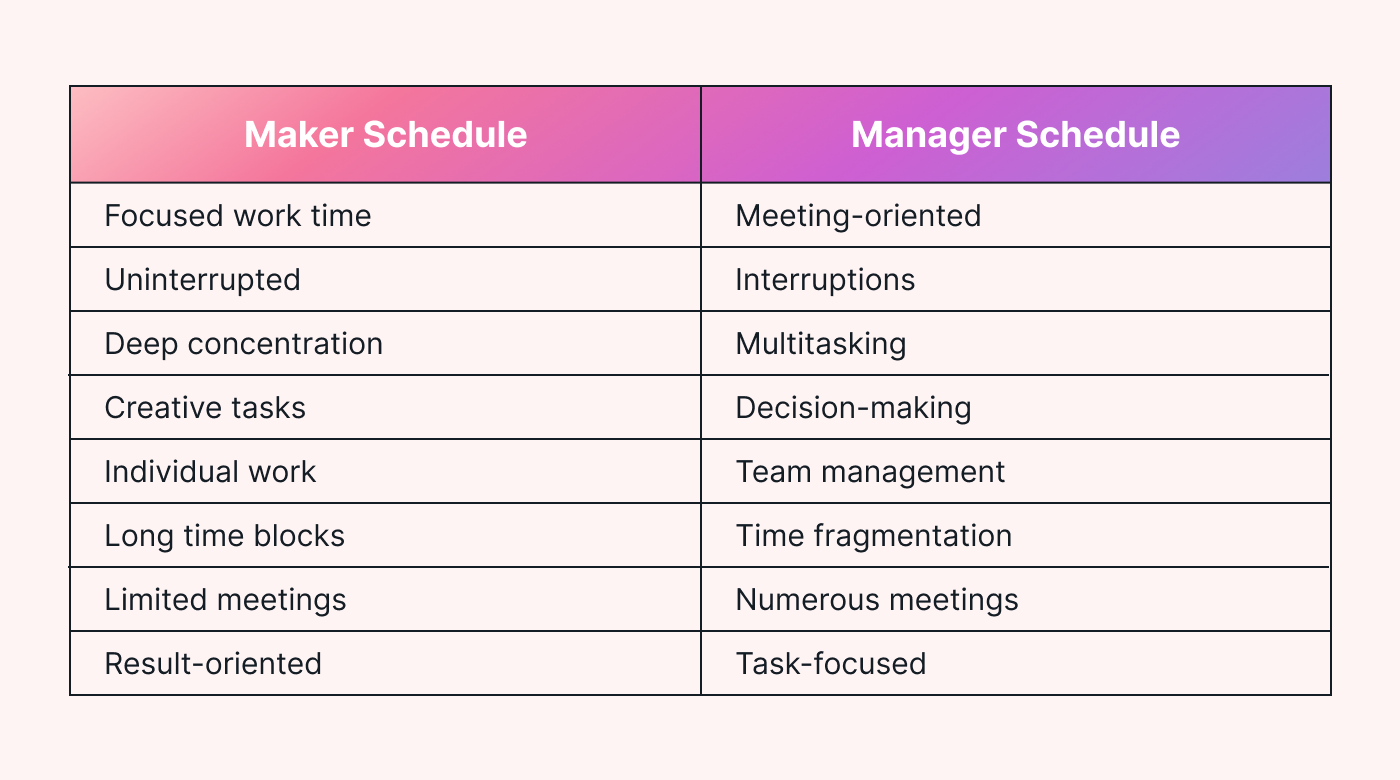 |
The paradox illustrates the distinction in how makers and managers approach their work schedules. Makers thrive when they immerse themselves in their creative projects, free from distractions. Managers operate differently. They use frequent meetings and adaptability to handle changing priorities.
Not everyone can strictly adhere to just one schedule type. Managers may also need dedicated time for focused work. Conversely, creatives may require time to manage team members, reports, or systems.
For example, imagine Bob, a manager at a creative agency who works an average of nine hours a day. Bob has a large team with many departments working under him, and he's always in meetings. This means he has limited time for his admin work, to update all involved and help with technical work. Similarly, one of his writers, Sarah (a maker) misses out on producing her best work because she is always being interrupted and called into meetings.
Conflicts faced by makers’ and managers’ schedules
The paradox between makers’ and managers’ schedules poses a few challenges.
Maybe the top challenge most managers and creators face is meeting overload. It means exactly what it sounds like. Too many meetings (and those meetings take too long). But how do you get around meetings, but still put information or asks out and look for feedback?
Many are turning to asynchronous communication using email or project management software. By doing so, information can be shared, and feedback is solicited without interrupting workflows.
Distractions and context-switching adversely affect both, the manager's and the maker's output. Research reveals that the average Slack user sends 200 messages daily. Just think about how many interruptions that is. And regaining that focus isn't easy. Research shows it takes about 23 minutes to get back into the flow.
If you can way too easily relate to these in your day-to-day work life, maybe it's time to use (pun intended) timeboxing.
Make timeboxing work for your schedule
Timeboxing is a game-changing productivity and time management technique. Simply put, you create time boxes (periods) for specific work with no distractions.
Combining timeboxing with deep work is a match made in heaven. Deep work, first coined by Cal Newport, is focused concentration on a single task, free from distractions.
For example, you could allocate three uninterrupted hours in the morning for creative work, such as time for writing or design work. Then you could reserve the afternoon to schedule meetings and a two-hour timebox for administrative tasks. Or vice versa if you are more creative later in the day.
Distractions are the enemy of deep work, and they're all around us. That's why timeboxing is a perfect fit for deep work time. And the more deep work you get in, the better. Another study shows that by doing deep work, we can rewire our brains over time to fire faster and work even deeper.
Another approach we can use is to prioritize tasks or goals (based on importance), and then use timeboxing to allocate dedicated blocks of time to work through those.
In a way, meetings are already their own timeboxes, but you can make them more productive for yourself and the team. To do so, set a specific agenda around a topic and send it to the team before the meeting. Once the meeting starts, keep it on time and take detailed notes. After the meeting, send out your notes (with follow-up assignments) via email and ask for feedback. This approach will help keep discussions productive and useful.
Some additional tips for maintaining focus and productivity when timeboxing are:
- Minimize distractions: by turning off all device notifications and creating a work environment where you can focus.
- Create a good work environment: Find a quiet and comfortable place to work. Keep your workspace organized and have all the necessary tools within reach. A non-cluttered and organized work environment tends to help you stay focused.
- Take regular breaks: Use this time to stretch, relax, or engage in activities that help clear your mind. Regular breaks enhance focus and can prevent burnout.
Timeboxing with Motion
Motion is perfect for implementing timeboxing.
Motion offers optimized calendars that enable you to schedule and allocate time for your work. It also facilitates prioritization and can help you focus on the most crucial tasks.
Motion is particularly valuable for maker days. It's one of a few platforms that supports time boxing for deep work.
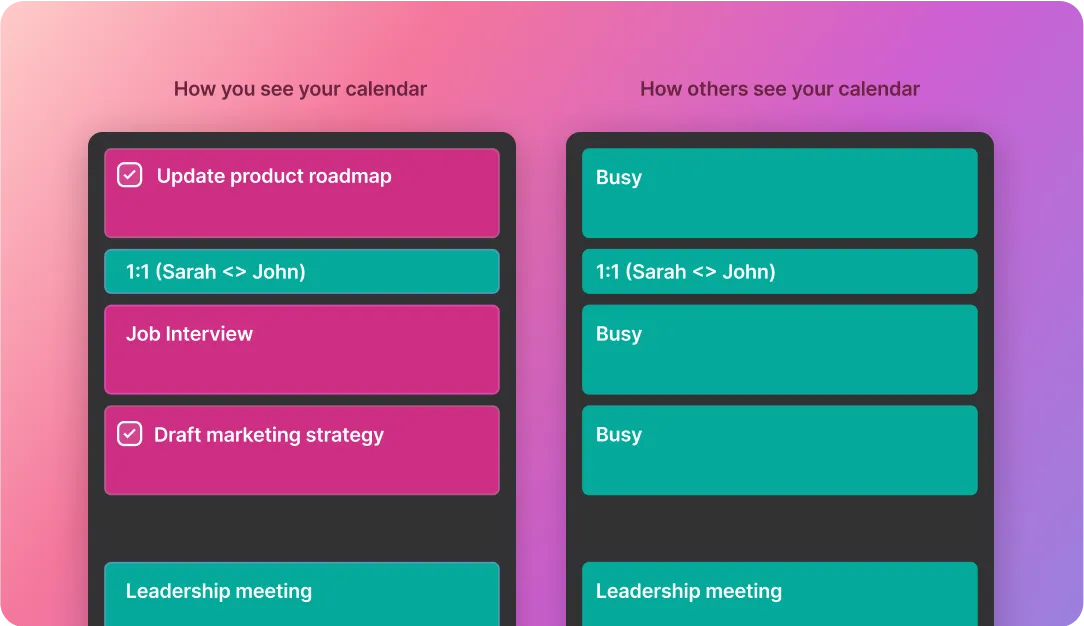 |
Not to be left out, managers can use Motion to prioritize tasks, delegate work, and track progress.
Motion also provides features for setting up and hosting meetings (and will let you know the best time for those).
Motion works with any schedule
Motion offers valuable features that can help you make the most of your time, regardless of your schedule. Many users save two hours per day after incorporating Motion into their workflows.
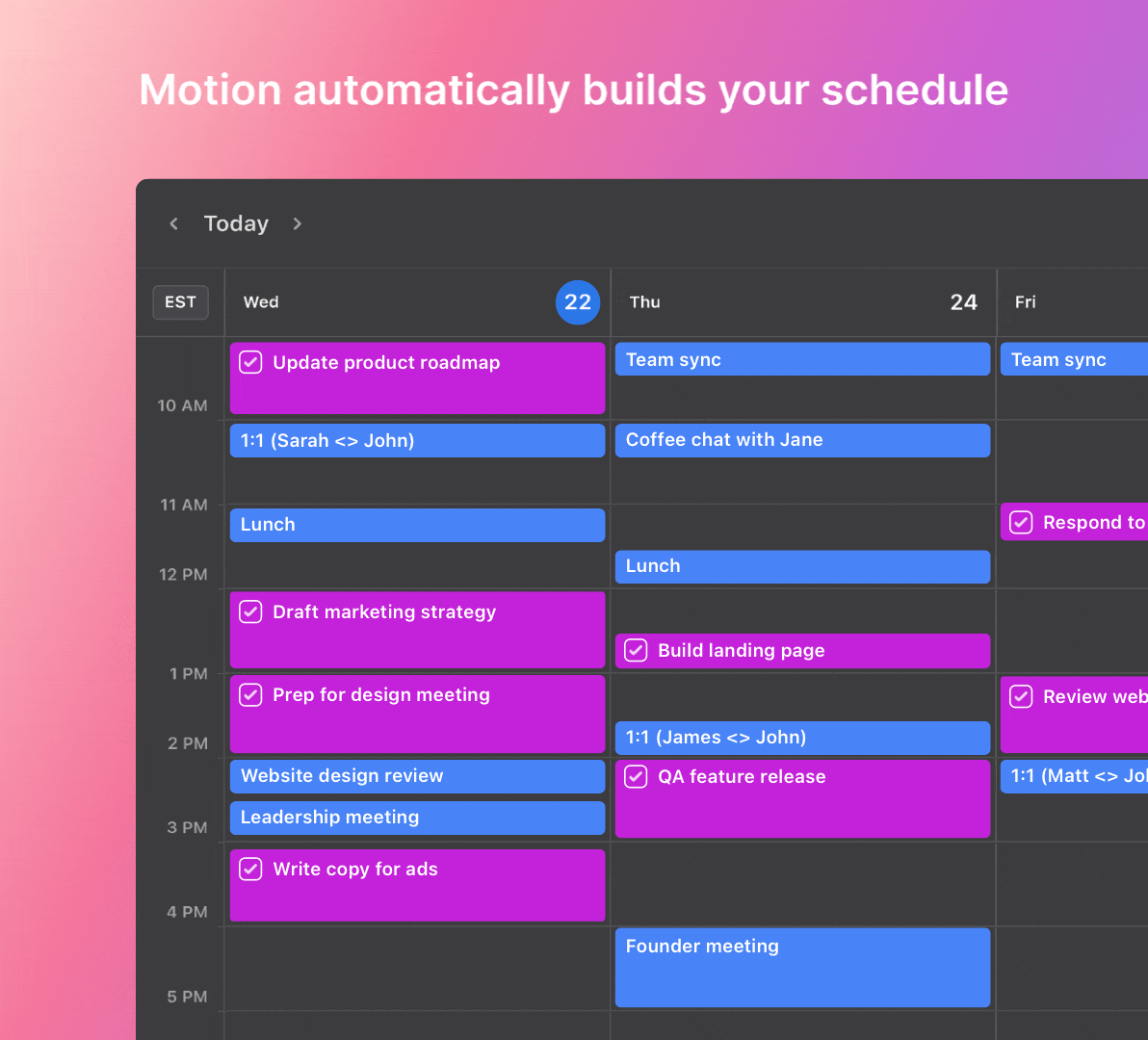 |
A key benefit of Motion is its ability to automate scheduling and task management. The app analyzes your preferences and priorities, then creates a schedule tailored to your needs. This automation removes the time-consuming process of manually organizing and prioritizing tasks.
Motion can also strategically manage your meeting schedule. By employing grouped meetings, Motion helps you maintain a healthy balance between teamwork and solo work.
Ready to conquer any schedule? Start your 7-day trial of Motion.

